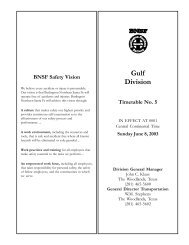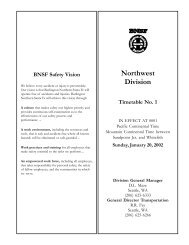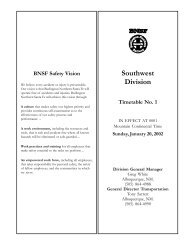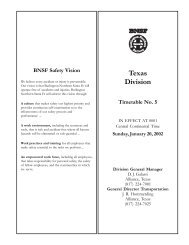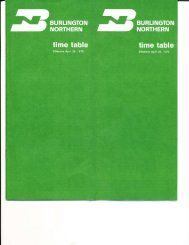2 11/5/03 - Friends of the Burlington Northern Railroad
2 11/5/03 - Friends of the Burlington Northern Railroad
2 11/5/03 - Friends of the Burlington Northern Railroad
You also want an ePaper? Increase the reach of your titles
YUMPU automatically turns print PDFs into web optimized ePapers that Google loves.
54 NORTHWEST DIVISION—No. 2—November 5, 20<strong>03</strong>—Scenic Subdivision<br />
Amtrak Talgo Maximum Speeds ....................... Passenger<br />
MP 3.4 to MP 1.6 ................................................. 35 MPH.<br />
MP 1.6 to MP 0.0 ................................................. 30 MPH.<br />
1(C). Speed—Switches and Turnouts<br />
Passenger Freight<br />
Through dual control turnouts<br />
at <strong>the</strong> following locations:<br />
Olds Jct. ......................................................... 25 MPH. ....... 25 MPH.<br />
Cashmere, Leavenworth, Winton,<br />
Merritt, Berne .............................................. 30 MPH. ....... 25 MPH.<br />
Scenic, Skykomish, Baring,<br />
Gold Bar, Monroe, Galer St. ....................... 20 MPH. ....... 20 MPH.<br />
Snohomish Jct. West and PA Jct. ................... 12 MPH. ....... 12 MPH.<br />
Lowell Jct. ....................................................... 10 MPH. ....... 10 MPH.<br />
Everett Jct. ..................................................... 25 MPH. ....... 25 MPH.<br />
Howarth Park ................................................... 35 MPH. ....... 35 MPH.<br />
Mukilteo ........................................................... 30 MPH. ....... 30 MPH.<br />
MP 28, MP 27, MP 18, MP 16,<br />
MP 8, MP 7, MP 5.4, 23rd St. ......................... 35 MPH. ....... 35 MPH.<br />
Trains over 100 TOB must not exceed 25 MPH through turnouts shown to<br />
exceed that speed.<br />
1(D). Speed—O<strong>the</strong>r<br />
Seattle—Over public crossings ........................... 20 MPH. ....... 20 MPH.<br />
Trains 143 TOB and greater on descending grades:<br />
Westbound MP 1700.0 to MP 1731.0 ..................................... 15 MPH.<br />
Eastbound MP 1700.0 to MP 1693.0 ...................................... 15 MPH.<br />
Mukilteo MP 29.0 to MP 27.0 (HER) ........................................... 30 MPH.<br />
Between North Portal and King St. Station,<br />
Seattle ............................................................. 30 MPH. ....... 20 MPH.<br />
Ballard Low Line ................................................... 5 MPH. ....... 5 MPH.<br />
Ballard—Over Bridge 6.3 ..................................... 20 MPH. ....... 20 MPH.<br />
Cascade Tunnel—Eastward Freight Trains<br />
passing signal 1700.6 with o<strong>the</strong>r than clear aspect<br />
under 100 TOB ....................................................................... 20 MPH.<br />
over 100 TOB ......................................................................... 15 MPH.<br />
Between Everett Pier and Mukilteo, while handling 24-foot hi-wide Boeing<br />
Container cars, move at Restricted Speed.<br />
Temperature Restrictions<br />
When ambient temperatures between Wenatchee and <strong>the</strong> East Portal,<br />
Cascade Tunnel at Berne exceeds 90 degrees Fahrenheit, <strong>the</strong> maximum<br />
speed for trains is 60 MPH passenger and 50 freight. In addition, trains<br />
exceeding 100 TOB must not exceed 35 MPH.<br />
When ambient temperatures between <strong>the</strong> West Portal, Cascade Tunnel at<br />
Scenic and Seattle exceeds 85 degrees Fahrenheit, <strong>the</strong> maximum speed<br />
for trains is 60 MPH passenger and 50 MPH freight. In addition, trains<br />
exceeding 100 TOB must not exceed 35 MPH.<br />
See Item 1 <strong>of</strong> <strong>the</strong> System Special Instructions for additional<br />
speed restrictions.<br />
2. Bridge and Equipment Weight Restrictions<br />
Maximum Gross Weight <strong>of</strong> Car<br />
Wenatchee to Seattle ............................. 143 tons, Restriction B<br />
Six-axle locomotives and six-axle derricks not permitted and<br />
not more than two (2) four-axle locomotives on Standard Oil<br />
spur, located 2.6 miles west <strong>of</strong> Edmonds.<br />
Six-axle locomotives and six-axle derricks not permitted on <strong>the</strong><br />
Dyke Team Track.<br />
3. Type <strong>of</strong> Operation<br />
CTC—in effect:<br />
Olds Jct. MP 1652.8 to MP 7.7<br />
North Portal MP 1.4 to Seattle (King St. Station) MP 0.0<br />
ABS—in effect:<br />
Wenatchee MP 1650.2 to Olds Jct. MP 1652.8<br />
MP 7.7 to North Portal MP 1.4<br />
Two Main Tracks—<br />
Wenatchee to Olds Jct.<br />
MP 1650.2 to MP 1652.9<br />
North Track designated W.O. Main<br />
South Track designated main Track<br />
Everett Jct. to Seattle<br />
MP 32.1 to MP 27.8<br />
MP 27.1 to MP 17.8<br />
MP 15.9 to MP 7.7<br />
MP 7.4 to MP 5.4<br />
MP 3.4 to MP 0.0<br />
Occupancy Control System—in effect:<br />
MP 7.7 to North Portal MP 1.4<br />
Yard Limits—in effect:<br />
Wenatchee MP 1650.2 to Olds Jct. MP 1652.8<br />
Trains and engines must communicate with <strong>the</strong> Seattle East or<br />
Seattle Side Dispatcher before entering <strong>the</strong>se limits.<br />
MP 7.7 to North Portal MP 1.4<br />
Trains and engines may occupy <strong>the</strong> main track on signal<br />
indication <strong>of</strong> a controlled signal or verbal OCS permission.<br />
Manual Interlockings Not Using Track and Time (Rule<br />
10.3) to Protect MW Employees—Galer Street, MP 4.0,<br />
Interbay, 23rd Street, MP 5.4, Ballard, MP 7, MP 8—<br />
Maintenance <strong>of</strong> Way employees may occupy interlockings on<br />
OCS authority from train dispatcher.<br />
A. The Movement <strong>of</strong> Hyrail and On-track Equipment<br />
Drawbridge 6.3:<br />
Maintenance <strong>of</strong> way employees may occupy<br />
interlocking on OCS authority from train dispatcher but<br />
must obtain verbalpermission from bridge tender.<br />
Bridge Tender must provide protection for movement<br />
until Maintenance <strong>of</strong> Way employee has reported clear<br />
<strong>of</strong> <strong>the</strong> limits <strong>of</strong> <strong>the</strong> bridge interlocking.<br />
B. Entering <strong>the</strong> Limits <strong>of</strong> Ballard Bridge, for inspection or<br />
minor work –Maintenance <strong>of</strong> way employees may<br />
occupy interlocking on OCS authority from train<br />
dispatcher but must obtain verbal permission from<br />
bridge tender. Bridge Tender must provide protection<br />
for Maintenance <strong>of</strong> Way employee until employee has<br />
reported clear <strong>of</strong> <strong>the</strong> limits <strong>of</strong> <strong>the</strong> bridge interlocking.<br />
C. All o<strong>the</strong>r work within <strong>the</strong> Limits <strong>of</strong> Ballard Bridge<br />
Interlocking:<br />
OCS must be obtained from <strong>the</strong> dispatcher and<br />
protection provided by <strong>the</strong> bridge tender.<br />
D. Entering <strong>the</strong> Limits <strong>of</strong> <strong>the</strong> Ballard Bridge Interlocking to get<br />
to <strong>the</strong> Bridge Tender’s Hut or for Shift change:<br />
Bridge Tender must be contacted to request verbal<br />
permission prior to entering <strong>the</strong> limits <strong>of</strong> <strong>the</strong> Ballard<br />
Bridge interlocking. Bridge Tender will assure protection<br />
to allow entrance to <strong>the</strong> limits <strong>of</strong> <strong>the</strong> interlocking and<br />
passage to <strong>the</strong> Bridge Tender Hut. Blocking <strong>the</strong> control<br />
panel for main 1 and main 2 will provide protection.<br />
E. Ballard Bridge Log Book for recording Protection provided<br />
by <strong>the</strong> Bridge Tender:<br />
The Bridge Tender when providing protection on <strong>the</strong><br />
Bridge must record in writing and do <strong>the</strong> following:<br />
1. Name <strong>of</strong> person requesting protection.<br />
2. Date and time <strong>of</strong> request.<br />
3. What protection is being provided, i.e. bridge, locking,<br />
main 1 blocking, main 2 blocking or a combination <strong>of</strong> <strong>the</strong><br />
three.<br />
4. If OCS is required, ascertain if <strong>the</strong> person requesting<br />
<strong>the</strong> protection has an OCS permit.<br />
5. Place <strong>the</strong> appropriate key(s) in <strong>the</strong> logbook.<br />
6. Initial protection provided.<br />
7. Give requesting party verbal verification <strong>of</strong> protection.<br />
8. Date and time <strong>of</strong> reporting clear. The person<br />
requesting protection <strong>of</strong> <strong>the</strong> Bridge Tender must not<br />
consider protection in place until <strong>the</strong> bridge tender has<br />
given verbal permission to enter <strong>the</strong> limits <strong>of</strong> <strong>the</strong> Ballard<br />
Bridge Interlocking.




